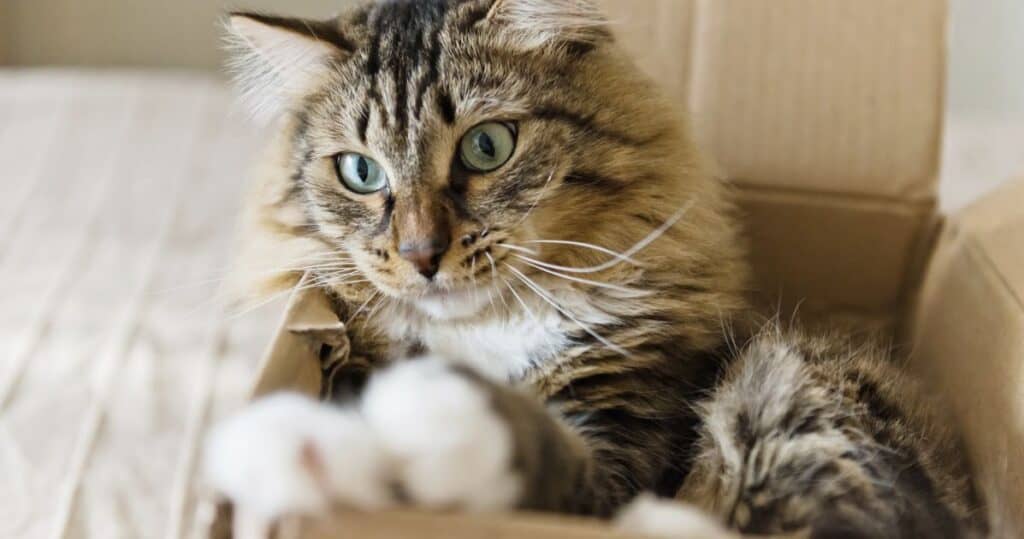A move itself is difficult enough, but moving cats.. when you move with cats it can all become a lot more complicated. Most cats don't like change at all and this can make it even more difficult for you as owner. Expect the process to be extremely slow at times.
Moving is a stressful
A moving cat is therefore complicated. But why exactly? What we mean by this is not necessarily that the cat itself is difficult to move, because that is of course not the case. You can move a cat in a basket, but what we're talking about is what's involved here. During such a stressful period, the animals can behave differently.
Not every cat is the same and we know that too.. maybe your cat is very shy while another cat is much more relaxed. You, as the owner, know your cat best, of course. However, it might be useful to know that a move is one of the most stressful events in a cat's life and that the right guidance is of great importance.
Cats are creatures that like control. It's simply in their DNA to be in control of everything. Unfortunately, they cannot do this during a move, which can cause them to experience enormous stress.
A change from the old territory
As you have read before, a cat loves control. This also means that the cat wants to know where it stands at all times. That is why it is extra important for you as the owner to be predictable in your reactions during a move. When you experience a lot of stress, your cat will also feel this, which can also cause stress. Therefore, during the entire move, make sure not to let the cat notice this and also be clear and normal in your reactions to the cat.

Strange cats and other cats
Some people prefer to send their cat to a shelter during the move. There are several cats and different cats with which they will not feel alone. The caretakers in a shelter also know exactly how to take care of the cat. This way the cat can get used to it in peace. This is not only pleasant for the cat, but of course also for you as the owner. This way your cat can temporarily disappear from all the chaos without getting anything from the move.
Naturally, professional carers always work in a shelter. They know exactly how to feed and care for your cat. Before you make an appointment you will first have to participate in an intake interview. This way the caretakers and you as the owner can discuss everything. To prevent unwanted behavior, they will often also ask you to provide a soft cotton cloth that contains the old and natural scents that your cat is so attached to. This is reassuring.
What if your cat runs away?
Of course, a pet can always run away. This can happen at both a shelter and at your new home. That is why it is so important that your cat is chipped. Before moving, make sure that you pass on the address of the new house to the vet or database.
Have the cats gotten used to it?
Yes, cats cause stress for you as an owner during a move, but of course they also cause a lot of stress for themselves. That is why it is especially important during a move to give your cats enough time to get used to the new home. This is especially true for a shy cat or an insecure cat. Getting your cat used to it is actually the most important thing there is.
It is important to keep your pet's familiar routine the same until the last minute. Think of the old environment, but also, for example, the familiar smells. In the new home your pet sees many new things and smells new smells and it is important that the pet gets enough time to get used to this. It is therefore wise to put his old toys, cat bed and litter box in a quiet corner or room so that the cat can get used to his new environment.
Have you placed your pet in a room? Make sure that all doors and windows are closed properly and that all doors and windows remain closed! If you don't do this, your pet can run away and of course you don't want this. It doesn't happen very often, but it sometimes happens that a cat walks back to the old house. And in the old house, of course, no one is standing guard there. And you keep the cat indoors forever of course you don't want to. Especially not when it comes to a real outdoor cat.
It is therefore extremely important that your pet can get used to it quietly, otherwise it may even prove necessary that the pet has to be rehomed due to serious behavioral problems and of course you don't want this as your owner.

A cat room
If you have a nervous cat, it may be best to put it in a separate room. It must be a room in which you have already put things. A family member can also stay in the room with the pet. Hide kibble dry food and play games with the cat so that the cat hardly notices the environment. The cat can still explore the new environment at leisure later on.
The day of the move
Yes, your pet has to get used to its new environment in the new home, but don't forget to pay attention to your pet in the old house on the moving day itself? As you have read before, it is best to 'lock' your cat in a room. Don't forget to put down his favorite lying baskets, hammocks, litter boxes and toys.
Moving your cat safely is best done last. Is the new home nearby? Then of course you can walk there with your cat. With your cat in a bench, of course. Was your cat in a temporary shelter or another room? Then your cat is surrounded by his favorite things and as long as he lives in his own protected living environment during the last moment of the move, this will only bring benefits.
Do you notice that your cat is scared? Then you can also use a special pheromone spray. The reassuring pheromones from the special spray make your cat calmer. The cat does not have to be alone all the time, of course. In the new home, for example, a family member can stay in the room with the cat while the animal explores its new environment.
Is your cat used to the new house?
Some cats are used to their new living environment in no time, but some cats can hardly get used to it. As the owner, it is best to look at this because you ultimately know your cat best.
Veterinarians always recommend that you keep your cat indoors for at least two weeks to about 6 weeks so that the animal can get used to its new environment. Two weeks is enough for most cats, but again, every cat is different.
When you see cats you don't quickly think that they are sensitive animals. They are not known for this at all. However, they are one of the most sensitive animals and therefore it is important to take this into account. Have you let your cat get used to it for two weeks and as an owner do you think it is ready to go outside? Then you can practice this.
By the way, are you afraid that your cat will walk to the old house? Then it might be useful to inform the new residents about this so that they can contact you immediately when the cat is at their door.

If it all takes a long time, it is of course not fun to let your cat look forward to it. However, it is also the case that if your cat gets used to it quickly, it can also go outside faster. Is your cat scared or if your cat persists in returning to its old home, it is obviously not a good idea to let your cat outside all the time. Stopping this slowly is the best option. When your cat is ready to go outside, you will notice this as owner.
Gradually introduce your cat to the inside and outside of your home. It is also important that you do not force your cat to go outside. The cat must be able to decide this for itself at all times. In the beginning, leave the door open for your cat to explore on their own. In this case, you should make sure that no strange cats can enter through the door.
By the way, are there many other cats in the garden? Then chase these away yourself because your cat can't do this at all in the beginning. Your cat must first get used to the new environment before it can mark its new territory.
Frequently Asked Questions
How do I keep my cat in the garden?
You can take your cat for a walk or close the garden tightly so that the cat cannot get out. You can also attach the cat to a harness. This way he can walk around freely, but not run away.
How do you keep your cat from running away?
Cats that have been neutered are less likely to run away. It is also important that you give the cat enough love, attention and food so that it does not run away.
How long should you keep a cat indoors?
It is advised to keep a cat indoors for 2 to 8 weeks after a move.
Can you let an indoor cat outside?
You can train your indoor cat to go outside, but if you see that your cat doesn't like this then it's better to give up.
Can a cat go outside after 1 week?
No, your cat cannot go outside after 1 week. If you do, there is a good chance that your cat will run away.

